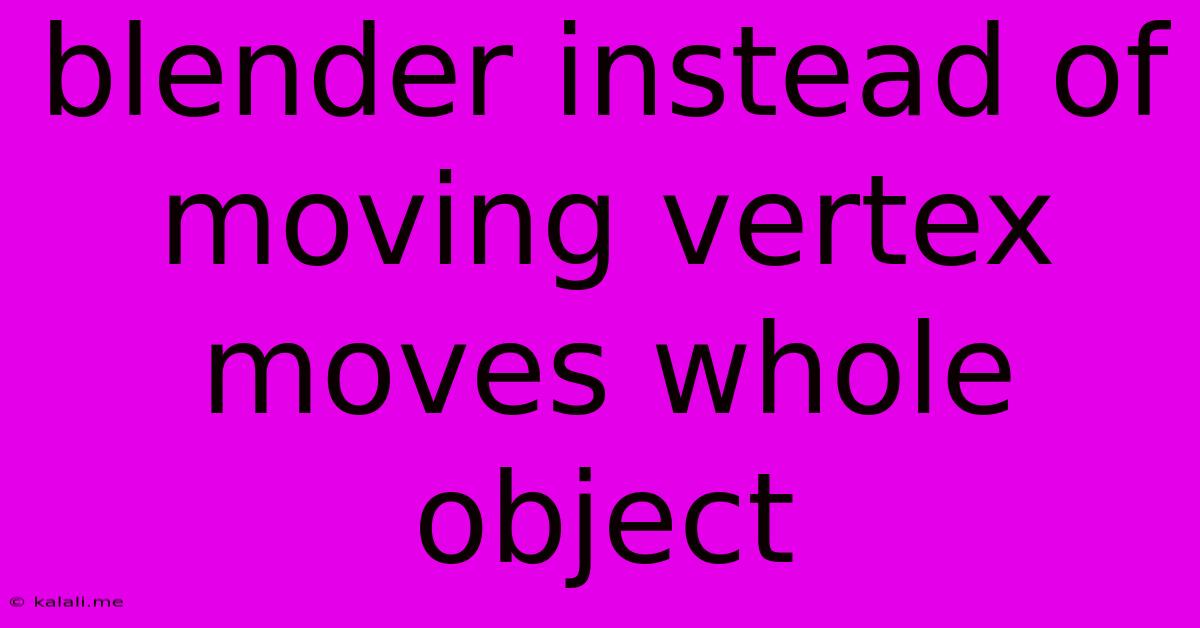Blender Instead Of Moving Vertex Moves Whole Object
Kalali
May 26, 2025 · 3 min read

Table of Contents
Blender: Why Moving a Vertex Moves the Entire Object & How to Fix It
Are you frustrated because moving a single vertex in Blender is moving your entire object instead? This common issue can be incredibly frustrating, especially for beginners. This article will diagnose the problem, explain why it happens, and offer several solutions to get you back to precise modeling. This issue usually arises from accidentally selecting the wrong mode or having constraints applied to your object. Let's dive in!
Understanding the Problem: The root cause is usually an unintentional selection of the entire object or an incorrectly applied modifier or constraint. Blender's intuitive interface can sometimes lead to unexpected behaviors if you're not aware of your current mode or object properties.
Why is this happening?
Several factors can cause this unexpected behavior:
-
Incorrect Selection Mode: You might be in Object Mode instead of Edit Mode. In Object Mode, you manipulate the entire object as a single unit. Edit Mode, on the other hand, lets you edit individual vertices, edges, and faces.
-
Parent-Child Relationships: If your object is a child of another object, moving a vertex in the child object will also move the parent object. This is because the child inherits the transformation of its parent.
-
Constraints: Constraints such as "Parent", "Copy Location", or others can restrict the movement of your object or parts of it, leading to unexpected behavior. Check the constraints tab of your object's properties panel.
-
Modifiers: Certain modifiers, like Armature modifiers, can influence the object's movement, potentially leading to the whole object moving when you attempt to edit a single vertex.
-
Incorrect Pivot Point: While not directly causing the entire object to move, an incorrectly set pivot point can influence the transformations and might give the impression of the entire object being affected.
How to Fix It: Troubleshooting Steps
Let's troubleshoot the issue step-by-step:
-
Check Your Selection Mode: Ensure you are in Edit Mode. You should see the orange highlight around your object in the 3D viewport. If not, press
Tabto toggle between Object Mode and Edit Mode. -
Verify Your Selection: Make absolutely sure you've only selected the single vertex you intend to move. Zoom in closely to your mesh, and use the selection tools (L for selecting linked elements, or Alt+RMB for selecting individual vertices) to confirm your selection. If accidentally selecting multiple vertices or faces, deselect unwanted elements by pressing A (to deselect all) and then carefully re-select only the desired vertex.
-
Inspect Parent/Child Relationships: In the Object Properties panel (accessible with the N key), look for a section on parenting. If your object is parented to another, temporarily remove the parent-child relationship to see if it resolves the issue. Remember to re-establish the parent-child relationship if necessary afterwards.
-
Examine Constraints: Check the Constraints panel within the Object Properties. Disable any constraints temporarily to see if they're interfering with your vertex manipulation.
-
Review Modifiers: Similarly to constraints, check the Modifiers panel. Temporarily disabling modifiers can help identify if one is causing the unintended behavior.
-
Check Your Pivot Point: In the 3D viewport header, you'll find a pivot point selection menu. Try selecting different pivot points (Bounding Box Center, Individual Origins, 3D Cursor etc.) to see if that affects the transformation behavior.
Preventing the Problem: Best Practices
- Always Check Selection Mode: Develop a habit of double-checking your selection mode before performing any edits.
- Use Precise Selection Techniques: Practice using the different selection tools in Blender to ensure accurate vertex selection.
- Understand Parenting and Constraints: Become familiar with how parenting and constraints affect object transformations.
- Regularly Check Modifiers: Understand the influence your active modifiers have on the object's behavior.
By systematically following these steps, you'll be able to identify and fix the issue, allowing you to precisely manipulate individual vertices in your Blender projects without accidentally moving the whole object. Remember, patience and careful attention to detail are key in Blender!
Latest Posts
Latest Posts
-
How To Say Is In Russian
May 27, 2025
-
How Do You Say Father In Japanese
May 27, 2025
-
What Is The Ln Of 1 2
May 27, 2025
-
Does Lifting Weights Affect Karate Performance
May 27, 2025
-
What Does Pot Of Greed Do
May 27, 2025
Related Post
Thank you for visiting our website which covers about Blender Instead Of Moving Vertex Moves Whole Object . We hope the information provided has been useful to you. Feel free to contact us if you have any questions or need further assistance. See you next time and don't miss to bookmark.